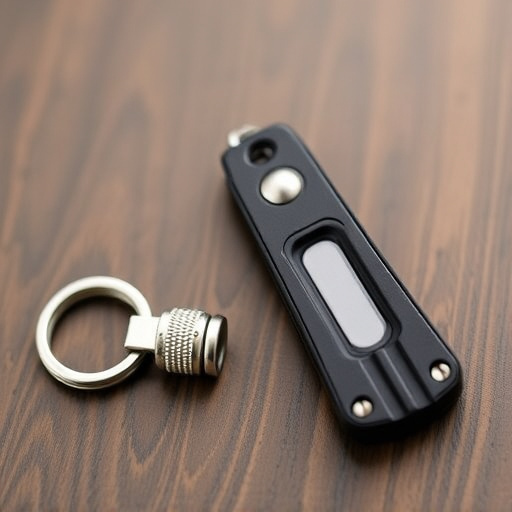Metal keychain defense tools provide discreet self-protection but require understanding local laws regarding their legality. Regulations vary widely, affecting age restrictions, training needs, and use conditions. Balancing personal security with legal constraints, users can select suitable tools based on comfort, ease of use, and desired protection level while adhering to regional guidelines for hidden weapons. Effective usage involves quick movements, targeting vulnerable areas, and combining defense with an escape strategy, ensuring legality through regular training and compliance with local laws governing metal keychain defense tools.
In today’s world, personal safety is paramount. One compact yet powerful tool gaining popularity is the metal keychain defense device—a versatile self-defense option easily carried in your pocket or bag. This comprehensive guide explores the intricacies of metal keychain defense tools, delving into their legal aspects, choosing the right device, and effective usage techniques. Understanding both benefits and limitations equips individuals to make informed decisions for basic protection.
- Understanding Metal Keychain Defense Tools
- Legal Aspects of Carrying Self-Defense Keychains
- Choosing the Right Keychain Defense Device
- Effective Techniques for Using Keychain Weapons
- Benefits and Limitations: A Balanced View
Understanding Metal Keychain Defense Tools
Metal keychain defense tools, often referred to as personal alarm keychains or self-defense devices, offer a convenient and discreet way for individuals to enhance their safety. These small yet powerful tools are designed to provide basic protection in various situations, especially when facing potential threats or attacks. The legal status of these devices varies across regions, so understanding the local regulations is crucial before purchasing and carrying one.
These defensive tools typically utilize a simple mechanism that involves striking a metal surface to produce a loud noise, which can startle an assailant and create an opportunity for escape. While they may not be intended as primary weapons, their effectiveness lies in the element of surprise they bring. It’s important to note that carrying such devices should always comply with local laws, ensuring you are aware of any restrictions or requirements regarding their use and possession.
Legal Aspects of Carrying Self-Defense Keychains
When considering a metal keychain defense tool for personal safety, it’s crucial to understand the legal aspects surrounding its carrying. In many regions, self-defense tools like keychains are regulated under specific laws and regulations, designed to balance individual rights with public safety. While these laws vary significantly from place to place, most jurisdictions have clear guidelines on what constitutes a legal defense tool and how it can be carried.
Carrying a metal keychain defense tool publicly may require you to meet certain criteria, such as age restrictions, training or licensing, and specific conditions for use. It’s essential to research and comply with local laws to avoid legal consequences. Understanding these regulations is the first step towards responsible ownership and effective personal protection.
Choosing the Right Keychain Defense Device
When selecting a keychain defense tool, understanding both your needs and the legal implications is crucial. Metal keychain defense tools offer an added layer of security for personal items like wallets and bags, especially in busy public spaces. However, it’s important to familiarize yourself with local laws regarding self-defense devices, as regulations can vary widely.
Choosing a device that suits your lifestyle and environment is key. Some models feature sharp points designed for puncturing or disorienting potential attackers, while others incorporate more subtle yet effective mechanisms. Legality aside, consider factors like comfort, ease of use, and the level of protection you require to make an informed decision that aligns with your safety goals.
Effective Techniques for Using Keychain Weapons
Using metal keychain defense tools can be an effective way to enhance personal safety, but it’s crucial to employ proper techniques to ensure their legality and maximize protection. For self-defense purposes, practice quick and confident movements when drawing the tool from your pocket or bag. Aim for vulnerable areas like the eyes, throat, or groin—these areas are sensitive and can temporarily disable an attacker. Always keep a clear path to escape if needed, as these tools are best used in conjunction with a well-planned retreat strategy.
Remember, legal restrictions vary by location, so familiarize yourself with local laws regarding hidden weapons, including keychain defense tools. Some regions have strict guidelines on their carriage and use, so ensure your actions comply to avoid legal repercussions. Regular training and familiarization with your chosen tool will improve your effectiveness, ensuring you’re prepared for any unexpected situations while adhering to the law.
Benefits and Limitations: A Balanced View
Metal keychain defense tools offer a range of benefits for personal safety, especially in scenarios where one might need quick access to self-defense measures. These compact devices can be easily attached to keys or bags, providing an additional layer of security and peace of mind. Their small size makes them discreet, allowing users to carry them without drawing attention, which is particularly useful in urban environments where crime rates may be higher.
However, it’s essential to acknowledge the limitations. While these tools can serve as a deterrent and provide temporary protection, they are not designed for extensive combat or as a primary defense mechanism. Legal considerations also come into play; the use of such devices must adhere to local laws and regulations regarding self-defense weapons, ensuring their possession and employment remain legal and ethical.
In conclusion, metal keychain defense tools offer a convenient and accessible form of personal safety. By understanding their legal implications and choosing the right device, individuals can empower themselves with basic protection. Effective techniques and a balanced view of benefits and limitations ensure these tools serve their purpose while adhering to legal boundaries. Stay prepared and informed for any unexpected situations.
